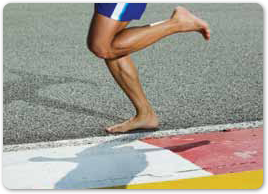
Barefoot running, also known as minimalism or natural running, is simply running without shoes or in thin-soled shoes. Proponents say our bodies and feet evolved to run with forefoot or midfoot striking. Running in shoes results in our heels’ striking first. Barefoot running is therefore a more “natural” experience, with barefoot running advocates arguing that it can correct a runner’s form and result in fewer injuries.
Running barefoot or in minimalist footwear—shoes that serve only as protection from cuts and other surface injuries, while providing no support—can help strengthen your foot and calf muscles in a new way because you land on your forefoot or midfoot with each stride. Your ankles and arches will become stronger as well. Benefits also include a “springier” feel to your running and the pleasant sensory experience of having the many nerves in your feet stimulated.
Running in typical shoes has, however, provided a comfortable, safe, secure experience for millions of runners for decades. Such shoes do protect feet from the elements and from various hazards on running surfaces. They also can help prevent overpronation (ankles rolling inward) and the shin splints that can result.
The key to transitioning successfully to barefoot running is to do it slowly and patiently; extreme calf stiffness or even stress fractures in the front of the foot can result from trying to go too quickly from shod running to barefoot running.
A transitioning plan could include taking very short barefoot jogs, at first, alternating with your usual shod runs, gradually lengthening the barefoot outings. Or, you might switch from running in your heavily supportive shoes to a less supportive pair, then to minimalist shoes, then finally to barefoot.
To help you transition to barefoot running as safely as possible, we can design a training program that will include strength training, endurance training, activities performed while standing on one leg and calf stretches for flexibility. Explosive exercises involving hopping, skipping or bounding with one or both legs, such as side-to-side hops, will condition your feet to withstand the impact with the ground.
With an exercise program, your hips and knees will feel less tired after a barefoot run, and your feel for the ground will increase. We can set up a series of exercises that will make the most of your transition to barefoot running and meet the goals you have set for yourself.









